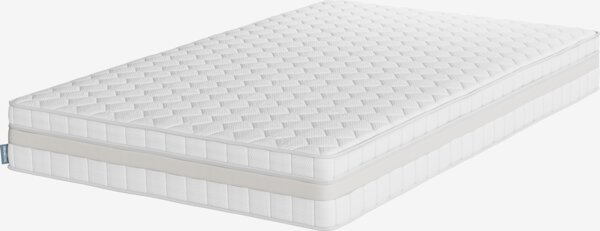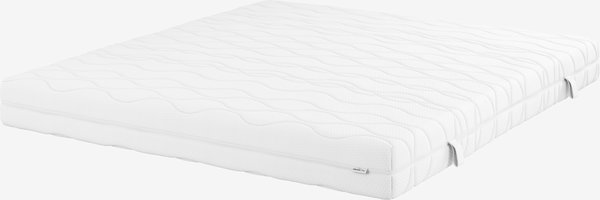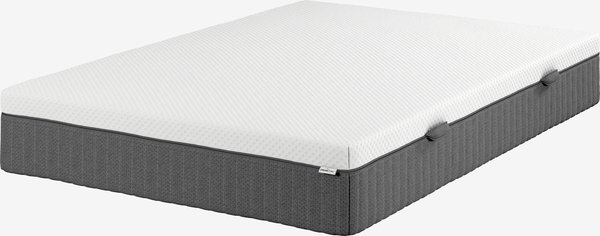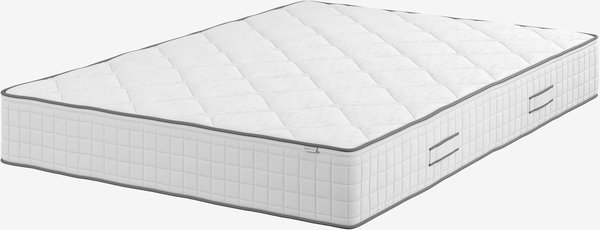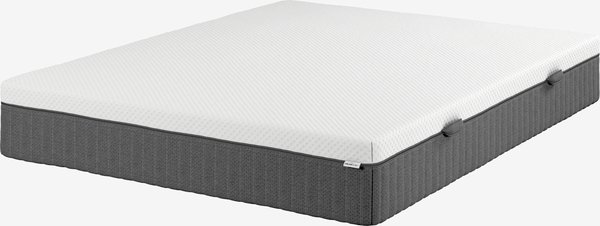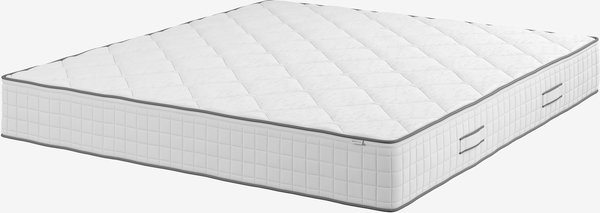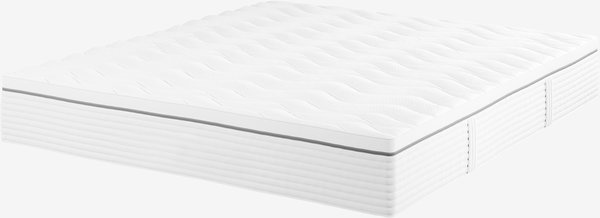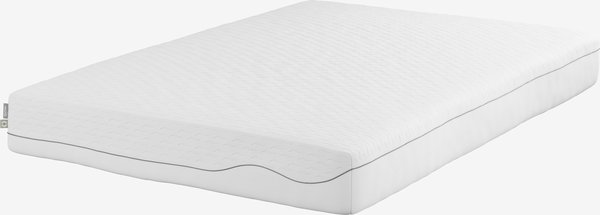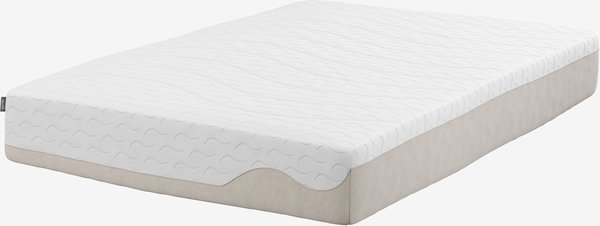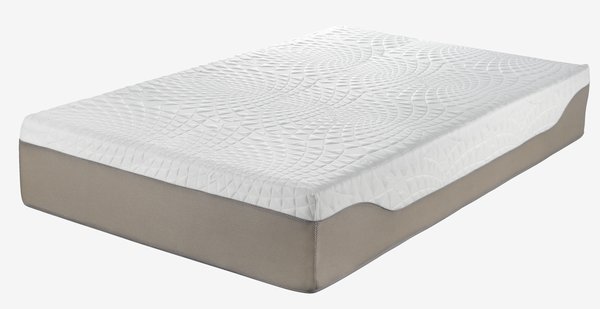When you're ready to buy a new mattress, there are many factors to keep in mind. Everything from materials and price to the way a mattress supports your preferred sleeping position needs to be considered before you decide on the mattress that is right for you.
In this guide, we've gathered the most important information you'll need to choose a mattress that will give you a good night's sleep.
1. What are the characteristics of the different mattress types?
There are different types of mattresses, and they all have different characteristics, advantages and disadvantages.
Below, we will go through the various types of mattresses, pros and cons, and give you the information and inspiration you need to decide which mattress is the right one for you.
2. Spring mattresses
A spring mattress has one or more layers of springs and a layer of filling, typically foam. This combination ensures optimal comfort and a mattress that will adjust to the contours of your body.
Springs make up the core of a spring mattress. At JYSK, we have two types of springs: (multi) Pocket springs and bonell springs.
- Pocket springs move independently of each other and give your body the best support during the night. Every individual spring is enclosed in a small cloth pocket that reduces wear and minimises mattress noise.
- Bonell springs are larger, which means that each individual spring covers a larger area. As a result, you won't get quite the same level of support and adaptiveness that you'll get from pocket springs.
Advantages of a spring mattress
- A spring mattress fits a bed frame or a continental bed
- The combination of springs and foam can possibly improve sleep quality for those who benefit from the good support of a spring mattress. The more springs, the more nuanced support.
- Some spring mattresses give side sleepers the deep shoulder zones they need for extra good support.
- Some spring mattresses can be flipped, and, in many models, the comfort is firmer on one side than the other. As a result, you essentially get two mattresses in one. This can be advantageous for couples who have different support needs.
- A spring mattress offers great breathability.
Disadvantages of a spring mattress
- Some spring mattresses may feel more lively than other mattress types. You're more likely to feel your partner's movements on a spring mattress than you are on other types of mattresses.
A spring mattress with bonell springs can make small noises when moving. In spring mattresses with pocket springs, each individual spring is enclosed in small fabric bags and therefore does not make noise.
3. Foam mattresses
A foam mattress can be made with several layers of different types of foam. A mattress that has a polyether foam core and a layer of memory foam provides great comfort. Memory foam allows a mattress to shape itself to your body.
Some foam mattresses can be flipped over, and in many models, one side of the mattress is firmer than the other. This allows you to adjust a foam mattress to your particular sleep needs.
Advantages of a foam mattress
- A foam mattress is very adaptable. Some foam mattresses almost enclose your body.
- A foam mattress can be less "lively" than a spring mattress, which means you are less likely to disturb your partner during the night if you toss and turn. And vice versa.
Disadvantages of a foam mattress
- The life span of a foam mattress is shorter than that of a spring mattress.
- The foam can lose some of its elasticity and adaptability over time.
Read more about why you should choose a foam mattress
4. Latex mattresses
A latex mattress is a foam mattress that contains a combination of natural or synthetic latex and other materials.
Latex is breathable and provides good support for your body. A latex mattress doesn't shape itself to your body to the same degree as a memory foam mattress.
A latex mattress "pushes back" on your body a little bit, making it feel relatively firm. A latex mattress is particularly good at providing support where the most weight pushes against it, which is typically at your shoulders and hips. This helps many people have better and more ergonomic sleep, particularly those who sleep on their backs.
Advantages of a latex mattress
- Dust mites cannot live in a latex mattress, so if you have a dust mite allergy, a latex mattress can be the best mattress for you and help you get a better night’s sleep.
- A latex mattress is made of natural, breathable material so it is a good solution for those who feel warm when they sleep.
- With support zones in the back and lumbar region, a latex mattress is a good choice if you sleep on your back.
Disadvantages of a latex mattress
- Side sleepers won’t get as much support for their shoulders and hips.
- A latex mattress can be more expensive than other types.
Read more about why you should choose a latex mattress.
Read more about the different mattresses.
5. What should you be aware of when choosing a mattress?
The most important thing when buying a new mattress is finding a mattress that makes you feel comfortable and helps give you a good night's sleep.
The factors that you need to consider include: the firmness, size, and price of the mattress, as well as your body weight, and which kind of bed you're buying a mattress for.
In the following chapter, we'll look at all of the above-named aspects so you can make an informed decision when you're ready to select the mattress that fits your needs.
6. How firm should a mattress be?
Your weight and body shape will help determine the firmness of your mattress. As a rule of thumb, the more you weigh the firmer your mattress should be. If you have a fuller figure, a mattress with support zones at the shoulders and hips is the right choice for you. A mattress with defined support zones will ensure that your shoulders and hips sink into the mattress the way they should and that your spine remains straight.
Learn more about the importance of choosing the right mattress firmness
Your weight | Mattress firmness |
Below 75 kg | If you weigh less than 75 kg, you'll want a medium-firm mattress. |
Between 75-95 kg | If you weigh between 75 and 95 kg, you should choose a firm mattress. |
Over 95 kg | If you weigh more than 95 kg, your mattress should be extra firm. |
7. The size of a mattress is important
When discussing mattress size, it's also important to consider how many people will sleep in the bed and how much space you have in your home.
There are a number of standard sizes that you can use as a guide.
Dimensions | Best for |
90x190 cm / 90x200 cm (Single mattress size) | Best for the guest room, where there isn’t space for a wide bed. A guest bed is typically 90x190 cm, so a single mattress is a perfect fit for a smaller room. Foam mattresses are typically the preferred solutions. |
120x190 cm (Queen size) 135x190 cm / 140x200 cm (Double mattress size) | A good solution for youngsters, teens and singles. Also works well in dorms or holiday homes, where there isn’t quite enough space for a wider bed. |
150x200 cm (King size) | A good solution for couples who live in a smaller flat. |
180x200 cm (Super king size) | The best choice for couples who live in a house or larger flat. A super king size mattress is also ideal if one partner moves around a lot while they sleep. With a 180x200 cm mattress, there’s also plenty of room for any children who may come sneaking in during the night. |
Read more about mattress sizes.
Your height is also a factor in choosing a mattress. As a rule of thumb, you should opt for a mattress that is at least 20 cm longer than your height.
If you sleep on a mattress that is too short for you, the built-in comfort zones won't match up with your body and you won't receive the support you need. This applies to both back and side sleepers.
8. Choose the right mattress for your sleeping position
When we talk about sleeping position, what we're really focusing on is the position in which you first fall asleep. It's the position in which you're able to relax your muscles and fall into a deep sleep. It's precisely this sense of relaxation that allows you to wake up feeling fully rested. Find a mattress which keeps your spine straight, when you lay in your preferred sleeping position. Our trained store staff can guide and assist you.
9. Which mattress fits which type of bed?
Your options when choosing a mattress depend on the type of mattress you find most comfortable and the type of bed you either already have or plan to buy.
In the table below, you can see which mattress best fits different types of beds.
Type | Spring mattress | Foam mattress | Latex mattress |
Bed frame | ✓ | ✓ | ✓ |
Continental bed | ✓ | ✓ | ✓ |
Bunk bed | ✓ | ✓ |
10. The best mattresses
You've likely noticed that there are many models from which to choose. So when buying a mattress what should you look for?
At JYSK, we are always ready to assist and advise you on your mattress choice so that you end up with a model that matches your specific needs, sleeping position and budget.
You can also read our other guides for more inspirational tips and advice on how to create the best sleeping environment possible.
Don’t forget to supplement your mattress with a mattress topper and a mattress pad. A mattress topper can extend the lifespan of your mattress and a mattress pad serves a hygienic purpose. Read all about mattress toppers and mattress pads in our guide.









